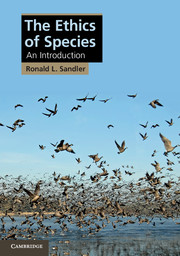Book contents
6 - The (in)significance of species boundaries
Published online by Cambridge University Press: 05 November 2012
Summary
The first part of this book concerned the value of species, particularly as it relates to species preservation and ecosystem management under conditions of global climate change. The second part, which begins with this chapter, concerns the ethical or normative significance of species boundaries, particularly with respect to species modification and species creation. Discussion of the value of species will not be left behind, however. One way to formulate the issue regarding the ethical significance of species boundaries is to ask whether species boundaries have value and, if they do, what sort of value it is, what the grounds for it are, and what the practical significance is of their having it.
This chapter concerns the ethical significance of nonhuman species boundaries. It addresses whether these are normatively significant in a way that provides an intrinsic (i.e., not outcome-oriented) justification against creation of transgenic organisms. Homo sapiens species boundaries are the focus in Chapter 7.
Interspecific hybrids and chimeras
The operative conception of species is that they are groups of biologically related individuals that are distinguished by their form of life. Members of different species have different ways of going about the world. There is, of course, variation within species. However, it is possible to distinguish the form of life of gorillas from that of chimpanzees and, still easier, from that of giant kelp and whitebark pine. They are different life forms, in that they have different genetic and phenotypic traits; and they go about the world in different ways, with respect to food, habitat, social interactions, and reproduction. Individual organisms are conspecific (i.e., members of the same species) if they are members of a biological group that share a sufficiently distinct form of life.
- Type
- Chapter
- Information
- The Ethics of SpeciesAn Introduction, pp. 130 - 156Publisher: Cambridge University PressPrint publication year: 2012



